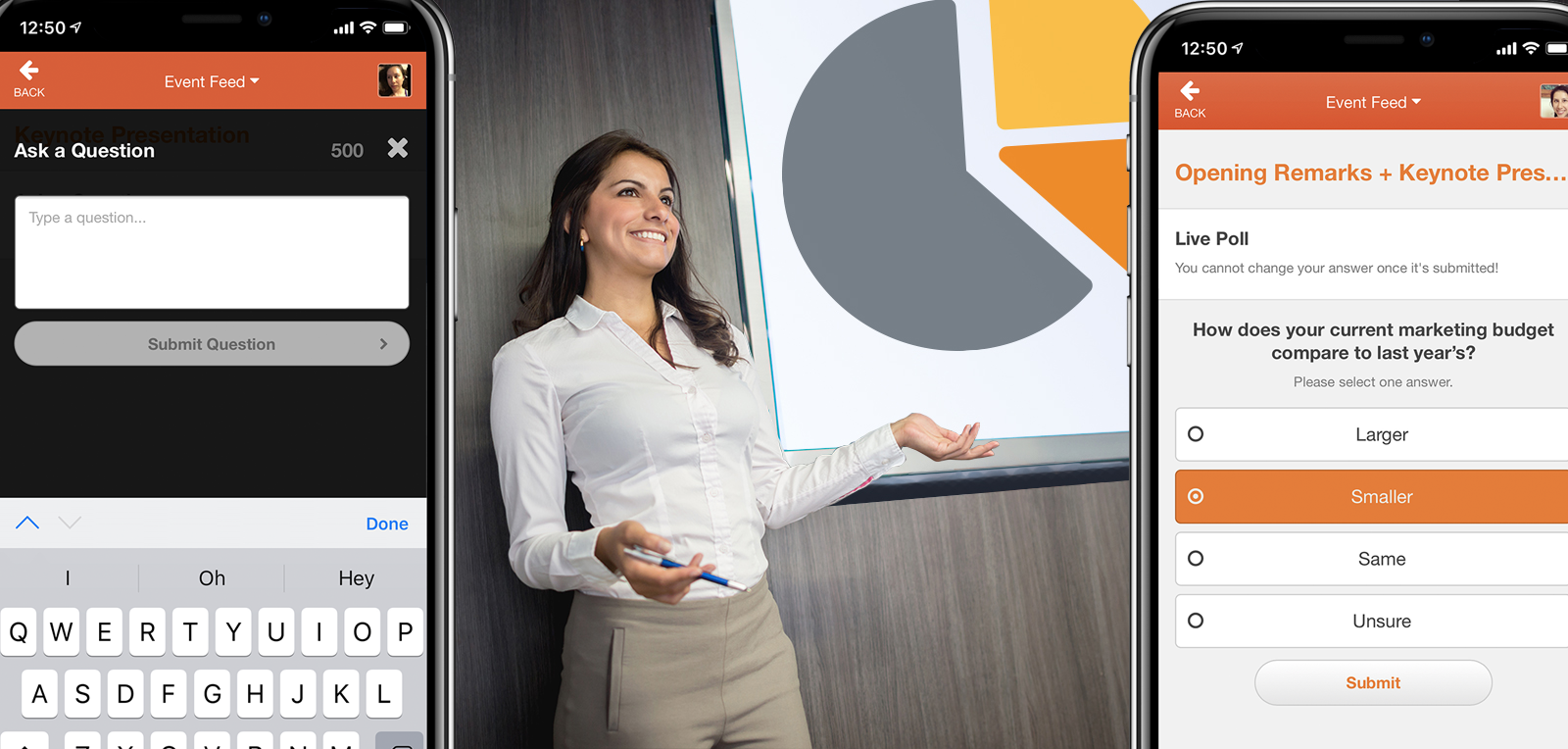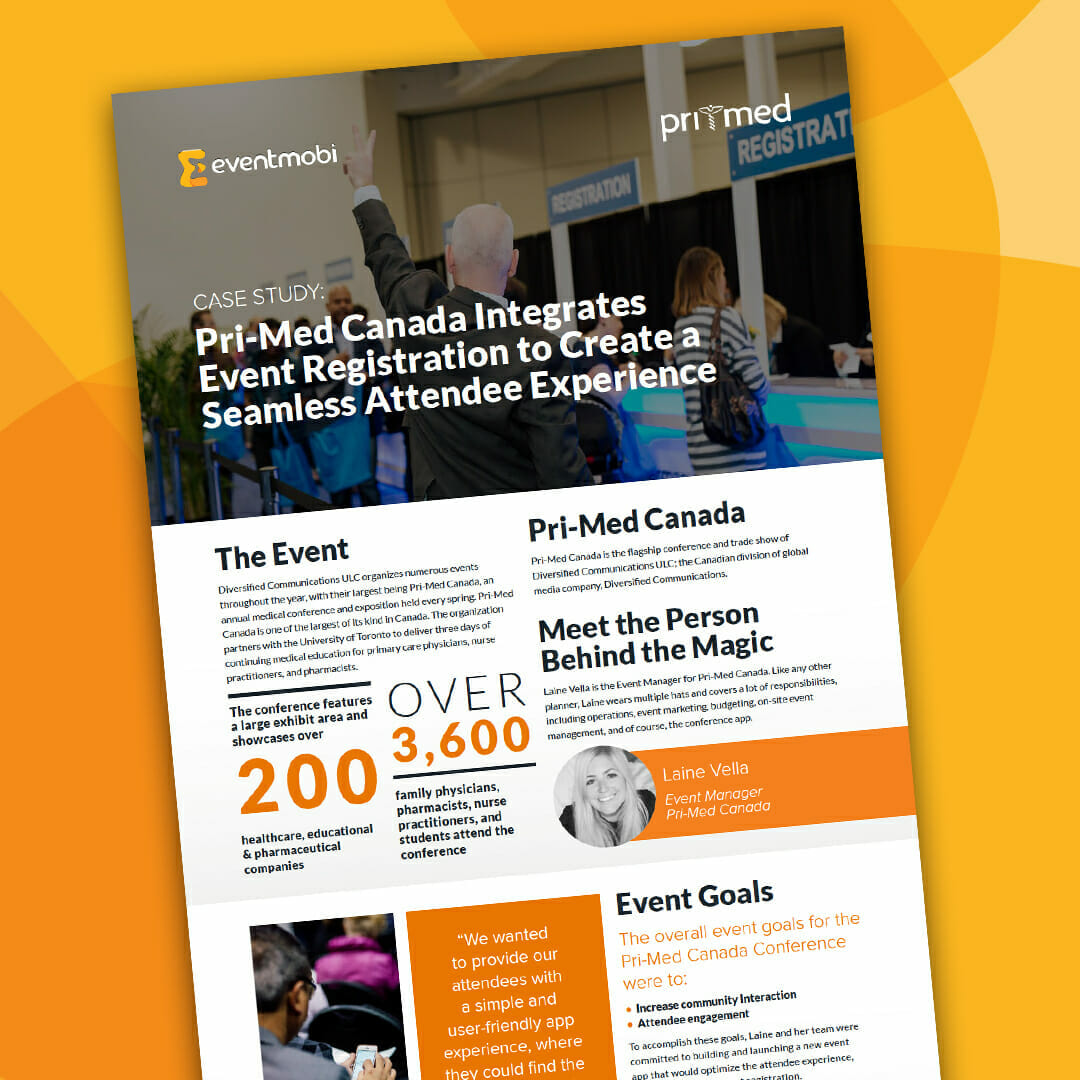How to Get Speakers to Use Live Polling and Q&A
Living Polling and Question and Answer (Q&A) tools are two easy and effective ways to engage attendees onsite. Additionally, they can also be used to gather immediate feedback and interest. Alternatively known as audience response systems, these tools offer a way for a large group of people to vote on a topic, answer a question in a poll, or ask a question.
Voting and Live Polling Systems Through the Times
Voting Keypads
The early 1990s saw the birth of voting keypads, similar in size to older mobile phones that had ten numbered buttons, using radio frequency. A base station would pick up the votes and feed them into the speaker’s laptop, where a plugin for PowerPoint would compile them and display them on the main screen. Voters needed to be in proximity of the base station in order for this system to work.
Today, only a USB dongle is required to collect the votes. Voting keypads are easy to use as there is no user onboarding required. A simple call out on a slide to draw attention to a poll or event survey will help increase adoption. On the other hand, keypads face logistical challenges because you need to set up the hardware and ensure that there is a keypad for every delegate, which has an associated cost.
Text Voting and Polling
The above technology is still around and heavily used at meetings and events. Technology, however, continued to evolve and text voting allows attendees to leverage their own devices instead. Attendees submit their vote by texting and a web page displays the results. SMS Response System take text inputs from your audience and receive multiple responses to questions per SMS.
Interactive SMS forums even allow attendees to answer questions posted by others. The advantage of SMS voting is that event planners don’t have to rent additional hardware. You need to be mindful if you have an international audience as some may incur increased costs.
In-App Voting and Polling Functionality
Technology has evolved even further and event apps now allow you to leverage built-in live voting and polling components. Most event apps allow the event organizer to create questions, including the question type, multiple choice, open text or star rating, ahead of time or on the spot. Questions can be displayed publically during or after a session and delegates select the appropriate answer and submit the poll.
In-App Q&A Functionality
Just like live voting and polling, Q&A can now be incorporated into the event app. Attendees love feeling heard, but often feel like they don’t have a voice, or are too shy to use it. Barriers like shyness deprive individuals the chance to be heard and deprive the session and its audience of the benefit of their insights and curiosity.
By making Q&A a prominent feature on your event app, attendees can bypass these obstacles and ask their own questions anonymously. Often event apps even allow delegates to up vote others’ questions of interest. Allowing everyone to ask their questions not only increases engagement with the event (and the technology), but it allows for more relevant content and increases the perceived value of your event as well.
The advantage of in-app voting, polling and Q&A functionalities is that you don’t have to administer additional hardware. You do however have to ensure attendees download the event app, have a stable WiFi connection and know where to find voting and polling in the app. To increase engagement and adoption, share the in-app features with your attendees and have your speakers promote the app on your behalf as well.
If you want to learn more about how to increase event app adoption at your event, view the Ultimate Guide on Event App Adoption.
How to Increase Engagement Throughout Your Session
The in-app Q&A functionality can be used in conjunction with a roaming microphone. To ensure a seamless Q&A process, the moderator can immediately begin receiving questions from the app without having to wait for someone to raise their hand for the mic. While the first question is being answered, the member of staff with the mic has time to identify the next person who wants to use the mic and switch to that format for the next question. In turn, the moderator receiving questions through the app can use that time to vet the submissions and determine the next one to read aloud.
Using a combination of both ensures that you have lots of content-rich questions without having any awkward pauses while you wait for someone to think of a question, and then have a mic passed to them. Always ensure to hold the mic yourself instead of giving it to attendees. This will allow more control over the Q&A portion of your session.
Ask Effective Questions to Turn Your Data Into Actionable Insights
Make sure that the event app you choose allows you to moderate voting and polling responses. All questions you ask your audience must be relevant and the speaker must be prepared to discuss the results depending on which way the audience responds.
If you are putting the Q&A on the event app, ensure you can hide questions by default, only revealing them once they are vetted. Letting attendees vote up a question that has been submitted by someone else lets the speaker know the burning questions from the audience as a whole and allows them to focus on the questions and comments that are most relevant to the most people.
All data collected through the event app is immediately available for display to the audience. Share insights with your audience on the spot to engage them further and give feedback to your speakers right away. In addition, all submissions may be used to formulate content for your next event or inspire a blog article in an industry publication.
Gauging the audience using live polls and surveys will help you get valuable information, but you need to ask the right questions to turn your data into actionable insights.
Here are some things to keep in mind when writing your questions:
- Speak their language
- Keep it simple and only ask about one idea at a time
- Give mutually exclusive choices, i.e. 10-20, 21-30, etc.
- Use balanced scales
- Do not use leading questions
- Do not use jargon
- Circle back to your objectives
The Top 3 Most Commonly Asked Questions
1. Open-Ended Questions
- Provide open-ended questions where possible
- Examples include:
- How did the use of group chat affect your event experience?
- How did the event address your biggest challenge?
- What did you enjoy most about the technology used in this session?
2. Multiple Choice Questions
- Ask your respondent to choose one answer from your list of answer choices
- Examples include:
-
- What is your favorite color?
-
-
- Red
- Green
- Orange
- Blue
-
3. Ranking Questions
- Ask respondents to rank a list of options in the order they prefer
- Examples include:
- On a scale of 1-5, how did the group chat affect your event experience?
- On a scale of 1-5, did the event address your biggest challenge?
- On a scale of 1-5, how would you rate the use of technology in this session?
Writing effective questions is a major part of getting actionable insight into your event. However, ensuring that attendees know how to answer a poll or survey and successfully implement it on-site is another challenge.
Best Practices By Type of Audience Response Tool
Live Polls
- Introduce that a Live Poll will be conducted at the start of the session
- Include a slide that has the steps to access the Live Poll
- Have the speaker introduce the poll and read the question out loud
- Have a slide that includes the question and answers for the poll
- Give attendees enough time to pull out their device, read the question and submit their response
- Switch to the Live Results page and have the speaker analyze the results
Q&A (aka Ask a Question)
- Discuss your decisions for moderation before the event
- Ensure you have the technology required (iPad for speaker, moderator, etc)
- Brief the speaker on how Ask a Question works and include scripting for them at the podium
- Have a slide at the beginning of the session that shows the process for submitting questions and show this at the end of the session during the Q&A time
Session Feedback
- At the end of a session, have the speaker remind the attendees that they can submit their feedback through the app
- Dedicate 5 minutes to the end of every session to allow them to provide their feedback
- Distribute a template slide for all presenters to add to the end of their presentations
Event Survey
- Mention in your closing session that an event survey is available through the app
- Send out an alert after the event has ended linking to the survey
What’s Next
Interested in learning more best practices about how to use live polling and Q&A?
Pri-Med Canada shares how they used live polling and other event app features like document sharing and interactive mapping to design engaging event experiences at their annual conference. Plus, they share their secret on how they saved over $8,000 in printing costs by using an event app!

